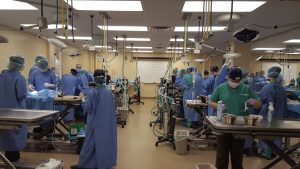
A full dress rehearsal using willed-body cadavers to prepare for a live animal ovariohysterectomy lab.
Written by guest blogger Erin Malone.
When I took over our skills program, I didn’t think too much about the brain science behind psychomotor skills learning. I spent much more time thinking about how to move 100+ students through each lab most efficiently. Students mostly loved the lab time—it was a nice break from the classroom and they felt like they were doing real veterinary things. However, they didn’t retain the skills well and were not confident entering clinics. Students also complained about sessions that we “never taught them”, despite us being able to point to the day and time in their calendar. Yes, we taught them—just not in a way that fit with how the brain learns.
My aha moment came more than a year later when I was asked to give a plenary talk about training models, particularly the value of high fidelity versus low fidelity. After I said yes, I realized I had 5 minutes worth of material. Both types of models work. To fill up the other 55 minutes, I began to explore other research on motor skills teaching. I quickly became dismayed and disheartened. Unfortunately, the brain works differently when learning motor skills than when learning knowledge—and our skills training program was breaking just about every rule. And there were few easy answers on how to be both effective and efficient. Finding the rehabilitation research was a lifesaver.
We started making the changes one year at a time. Our first cohort has hit clinics and they aren’t a great deal improved over previous years but we have learned a lot since that first year. The first item to go away was my “efficient” model of moving students through multiple different skills in one session. While it was efficient use of time, it was not efficient for learning. We had to cut our skills list down to the bone, realizing that introducing students to many skills often results in mastery of none. We take advantage of the testing effect and have “check-ins” to assess student progress on the core skills. We review and reassess skills each year to help with retention and to enable students to build on them successfully. We no longer push students to practice unsupervised, avoiding bad habits that then need to be corrected. We create videos and step-by-step guides to help our student visualize the skills and mentally practice.
Things are not yet perfect. We are now working on transitions—helping the students practice connecting the steps. We found our students were doing very well in their check-ins but everything fell apart when they had to put the pieces together for a live animal surgery. This will be a tradeoff—more transition practice means fewer individual skill check-ins. We will keep monitoring student abilities and confidence, as well as the literature. Maybe we can rest on our laurels eventually; I am thinking it will be a few years down the road yet. I am just so thankful I was asked to give that talk!
Erin Malone, DVM, PhD, Diplomate ACVS, is Professor, Large Animal Surgery and Director, Clinical Skills Program, University of Minnesota, Veterinary Population Medicine Department. Her latest article in Journal of Veterinary Medical Education entitled “Challenges & Issues: Evidence-Based Clinical Skills Teaching and Learning: What Do We Really Know?” is free to read for a limited time here.
Comments on this entry are closed.